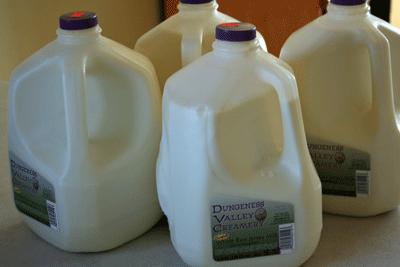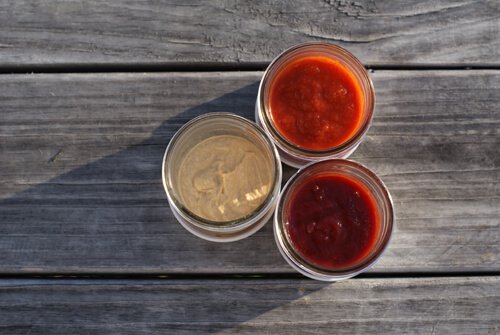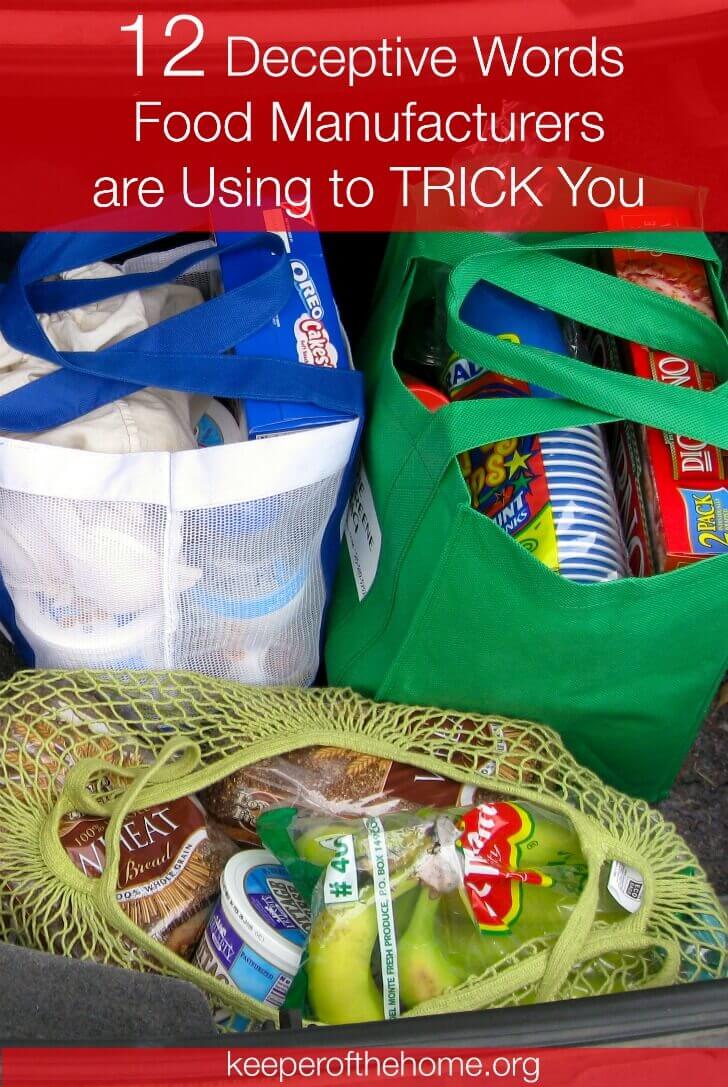Don’t Cry Over Sour Milk (Using Your Raw Milk Gone “Bad”)
A few years ago, I wouldn’t be caught dead suggesting that you use up and consume your soured milk products, let alone touch them myself. The proper place for them was down the drain!
That was until I became a raw milk advocate. Though it took a little bit of reading and researching to wrap my mind around it, raw milk or cream that has soured is actually NOT harmful or dangerous, but rather chock full of beneficial enzymes and good bacteria! (However, pasteurized milk is dangerous, as it is lacking these enzymes and bacteria, and rather than souring it putrefies- so avoid once it goes bad!)
This past weekend, my MIL scored 14 gallons of raw milk on clearance at her local health food store. Being down for a conference, I was fortunate to be able to take 4 of them off her hands! Only problem was they weren’t able to be frozen immediately after purchasing, so when I opened them up the day we brought them home, 3 out of the 4 had begun to sour significantly, and the 4th one was about to. Nonetheless, I froze them, knowing I didn’t have time to deal with them immediately.
I hadn’t been planning on using it all up at once, but a freezer switchover last night (and a 24 hour wait period before plugging in the new standup freezer) left me with nowhere to even keep these frozen. By morning they were 1/2 thawed in the garage, and I knew that I had no choice but to deal with them today. Besides challenging my kitchen skills (a challenge I’m always up for!), this is a great way to practice good stewardship of the food that God has blessed us with!
Here’s my plan:
** Make 2 gallons of yogurt
** 1/2 gallon of cream cheese and whey
** If any is still fresh enough, 1 gallon of kefir. If not, it may turn into yogurt as well. Or I may get more creative and come up with a different option.
** Soak a big batch of waffles using this natural “buttermilk”, to make tomorrow and freeze all the leftovers
** Make this Custard Pudding as a treat (towards bottom of article)
** Make some chocolate milk for my kids and I this afternoon, with a bit of carob powder and rapadura (for those wondering what carob is, I am planning to write a post on it in the near future!)
** If I am able to actually separate the cream (challenging because these are jugs, not open jars, and I don’t have a basting syringe to suck it up), then I will make some cultured butter, and make less yogurt than planned. Here’s a simple tutorial for making your own butter.
Interested in learning more about using your own raw milk or cream that has soured?
Learning to Maximize the Use of Your Real Milk and Cream– from the Weston Price site. Includes some great suggestions, and a few recipes as well.
When raw milk goes sour- I found this thread in the Mothering.com forums. There’s some good discussion on the topic, and lots of ideas of how people use their soured milk and cream.
Raw Milk: Discussing it’s Merits and Safety– for those not yet sold on raw milk, or wondering about the safety of all of this.
What do you do with your raw milk and cream that has soured? I’d love to hear your ideas (maybe it’ll change my to-do list)!






That’s the exact milk we buy! (But we’ve never had it sour; we go through it too fast!) 🙂
I started up the giveaway on my blog for your e-book today! Thanks!
Blessings,
Michele
We buy our raw milk in plastic jugs, and I have figured out a way to separate the cream and milk. I wash the gallon container really well with soap and water. Then I set the whole thing in a large bowl. Using a sharp knife, I cut the jug about 1/8th of an inch above the line where the cream stops and the milk begins. As I cut, the cream starts to leak out, and eventually all the cream pours out and only the milk is left. I then put the milk in quart jars and freeze until I need it. Hope that helps!
Oh, we just pour the milk into a large bowl and let it sit in the fridge overnight. The next morning, we skim the cream off the top, and ladle the milk back into the jug (using a funnel).
Michele 🙂
I don’t understand: it’s sour and then you drink the milk minus the cream? Isn’t it all sour? I have a couple of pints that are sour and I’m trying to figure out how to use it rather than throw it out.
I thought it was illegal to sale unpasteurized milk? I suppose that might be state legislature, but here my clients have to “lease” a cow and as part-owner then can obtain the unpasteurized milk. Otherwise, our only options are organic milk. Any advice?
In some states it is. Even in the states where it is illegal to sell raw milk you can still have your own private dairy animals and consume raw milk if that is your choice. Here in Kansas it is legal to sell raw milk, and products made from raw milk, provided that the milk is sold from the farm where the animals reside. I’m obligated by law to take anyone who asks out to see my animals my barn and where I milk them if they want to before purchasing milk. It’s a choice I make to be able to sell my raw goat milk period in Michigan where I grew up, it is illegal to sell raw milk, or raw milk products. So it just depends on where you live.
Those are great ideas for getting the cream out of the jugs! Unfortunately, mine still had too much frozen milk in them and I wanted to get it all dealt with, so I probably won’t end up doing butter. Next time, though, I’ll take the cream out before I freeze them.
With our usual milk, we go through it so fast and because we like to drink it whole, I don’t even bother with removing the cream.
Penny Lane, it’s illegal depending on the state you live in. Where my MIL lives in Washington, it’s legal to sell in stores or directly from farms. Where I live in Canada, I have to be a part of a “cow share” (like you mentioned) in order to get my raw milk. I think the only other option for those who live places where it is illegal is to make an arrangement with a local farmer or friends who live on property, or to get a cow yourself. Since I live in the suburbs, I do the cow share and it works for me. 🙂
Another option in some stores is pasteurized, but not homogenized, organic milk. This is still not ideal, but definitely a step above regular store milk.
This has nothing to do with raw milk, since I do not have a clue about it, but I went ahead and ordered your book. I REALLY like it. Thanks! I was happy to have it, and I’m getting started. Thanks.
Where I live in Minnesota we are fortunate to be able to buy raw milk from a local farmer. Farmers are not allowed to bottle the raw milk or advertise that they sell the milk, but people are allowed to come and “self serve” at the farm. We bring our own containers and serve ourselves out of the big holding tank.
My son loves to go and visit all the “baby cows” and see exactly where his milk comes from.
We found out about this farmer two years ago and prior to that my son wouldn’t even touch milk. He LOVES the raw milk! If you haven’t tried it, you won’t believe the difference. You will not want to go back to store milk ever again.
Thank you for your wonderful posts… I would have never thought to use my souring milk to make yogurt, but I will now!
My FIL has a milk cow so we all share the chores… and the milk. Between my 2 year old, my husband and myself we drink about 6 gallons per week! We’ve had fun experimenting with yogurt and butter. To make the yogurt, we just heat up the milk on the stovetop, cool it down a bit, add the plain yogurt starter and then pour it in an insulatewd Thermos to culture. Way easy. We also have some laying hens that keep us supplied with eggs… 🙂
Thanks for the tips! I also buy raw milk and once in a while it gets sour (not very often because we LOVE it). I haven’t made yogurt in a while, and I’m not sure why because it’s one of the easiest cultured milk to make. I do make kefir but I’m not real fond of raw milk kefir. I don’t like way it becomes more like curds and whey (does yours do that?).
I’m glad I found your blog. I love natural and healthy (although I don’t always take time to eat just right).
Have a beautiful day.
Lynnette
Dancing Barefoot on Weathered Ground
Thanks for the post! I have a question–does yogurt made from soured milk turn out differently than yogurt made from non-soured milk?
Also, I notice you actually boil the milk for yogurt. Do you find this is necessary. I only scald mine and my yogurt turns out pretty thick…but still not as thick as what I used to buy in the store (I can usually pour mine.) Do you think it’s because I don’t boil the milk?
Brandi, I haven’t been actually boiling my milk lately (I wrote that post well over a year ago), but now I’m only scalding mine as well. It’s been turning out just fine. Occasionally it’s a bit pourable, but usually I need to somewhat scoop it or help it along. I’ve never made yogurt as thick as what’s in the store, and I wonder if it’s because I don’t strain it, so it has all the whey in it? I do find that leaving it a bit longer sometimes helps it thicken a little more.
And I’ll let you know how it turns out with soured milk. Usually I use fresh (but previously frozen) milk, so I guess we’ll see! It looked amazing last night!
You can just let the milk sit out,sour and it will culture on its own. Then just drain off the whey and you have farm cheese! Add herbs and spread away.
I have dairy goats and spend a whole lot of time figuring up ways to use all of the milk!
Did you know that raw milk lasts longer if you store it in glass rather than plastic (we get ours right from the farm, so we have this option). I usually get two weeks’ worth at a time, and it’s never a problem in glass containers (although the cream gets pretty thick by the end of that second week!), while in plastic it will be sour by the end of the first week (my Dad even said he’s had milk over three weeks old in glass containers without it going bad)
I had no clue about a recipe i was planning to make which called for sour milk, so I found your site VERY helpful! Now I know that it is not telling me to use “bad” milk, just slightly bad milk, that is unpasturized. Unfortunately I dont think MI has the ability to buy unpasturized milk. But Maybe you will like this recipe!
2 c. sugar
1 c. molasses
1 c. melted lard (eeew! i substitute unsalted butter)
1 c. sour milk or coffee (don’t ask me why coffee, i have no idea)
2 eggs
3 tsp. baking soda
2 tsp. ground ginger
1 tsp. ground cinnamon
1/2 tsp. salt
1 tsp vanilla
Add enough flour to make a stiff dough, drop on greased cookie sheet and bake at 350 degrees.
I hope you like it! I love when my grandmother makes them, she puts a little red cinnamon candy heart in the center of them before baking. Too cute! She says to add about 2 tbsp less flour for softer cookies. So I guess that means make a soft dough instead of stiff? LOL I have no idea!
@Kristin, Kristin, just what is this a recipe for?
Btw, the best-tasting store-bought dough I’ve ever used was made with lard. So it can’t be that “eeew”.
I grew up in France next to a farm from which we got our milk. Mom boiled the one used for miscellaneous use but she saved some non-boiled one for cheese-making.
She would let it curdle naturally out. (We did not own a fridge). After it was curdled she would strain out perhaps half of the whey through a cheese cloth. We would eat this ‘curd” as is with a little raw cream and sugar. My Grandpa ate it with chives and salt. In the summer evenings we would eat it with boiled potatoes and a little salt or with strawberries for dessert. Any way you use it it is absolutely delicious and I could never get enough of it!
We would not get rid of the strained whey which would be fed to the pigs with boiled potatoes and chopped nettle leaves (a feast to them).
I understood that the process of souring or fermentation of the raw milk would kill any harmful bacteria.
Here in the US I buy certified raw milk and again let it curdle naturally. Now I do not strain the whey but just eat the whole thing. I think it keeps me healthy because when people have a cold around me I do not get it.
I have been reading the composition of raw milk but would love to be able to compare it with the composition of fermented raw milk? Anybody knowing? Thank you. Gabrielle
Do you know if you can make cheese from soured milk? My raw milk has soured, so sad – doesn’t taste tangy and sour though, tastes more ‘funky’ if you know what i mean. Is this okay?
I don’t do a ton of baking, so i can’t really think of what to do with a whole half gallon of milk. I already have some cream cheese and whey out on the counter that i’m waiting to coagulate. I know “cultured” raw milk is better for you than fresh, but i’m hesitant to eat something that tastes ‘bad’ to me.
Any tips would be great,
Miranda
For anyone looking for raw milk, I was able to find my source using http://www.realmilk.com
what did I just make?
I had some raw milk that tasted sour. Luckily I came across this post so was excited about using it rather than tossing it. I skimmed the very thick cream to make butter, and the rest into yogurt.
Here’s what happened with my butter-making attempt. I put the VERY thick cream in a glass jar and shook and shook. Instead of turning into butter and buttermilk, it turned into a nice yellow-ish white substance that’s about the texture of airy whipped butter.
Does anyone know what I made?
And, should I be concerned about the buttermilk still being in the “butter” ?
thanks,
claudia
Claudia,
You just almost made butter. It was just beginning to turn. A little longer and you would have had it. But that is the hard way to do it. Next time try it in your blender. Here’s how I do it. Keep the blender going until you can see the buttermilk separate from the butter. When you are sure it’s separated, pour out the buttermilk, saving it for mashed potatoes or pancakes or whatever, add cool water to the butter and blend again to clean the buttermilk out of it. Pour out the water and do it one more time. Then take a spatula, clean out the butter from the blender, smush it all around in a small bowl squeezing all the water out. When you’re sure all the water is out, form it into a ball and refrigerate. Hope this helps.
Hi, found your website trying to find sites discussing what to do when raw milk begins to sour. I knew it was “reusable” – still live – just couldn’t’ think, as it’s been awhile since I last was able to get raw milk. Anyway so the yoghurt idea is good – I’ve made yoghurt before but always used the sweet raw milk for it. So I’ll probably do that for now.
By the way, the link you had up here for the Weston Price group, how to maximize your real milk and cream – that link has changed and I got a 404 error page. The new link is:
http://www.westonaprice.org/food-features/517-maximize-your-real-milk-and-cream.html
hope that helps! (I know, I hardly have much of a website, nothing near this elaborate, and it’s hard to keep up with broken links!!).
Thanks –
Julia
@Julia, Thanks for that! It is definitely hard to keep up with broken links. 🙂
Greetings,
I make raw milk cheese and butter – the easiest way I’ve found to make butter is to put it in a mixing bowl and whip it with my stand mixer. I get butter in about 5 minutes this way. The “buttermilk” is then strained off, the butter is rinsed with cold water – i add a touch of sea salt and mmmm…YUMMY!!
Dancing in Delight,
~Namaste
I now actually look forward to the buttermilk waffles I make when the last of our milk starts to sour, and disappointed if we drink it all up before then. But I can still use kefir for whipping them up!
@Claudia – you made “almost butter”. Keep shaking it and it will seperate completely. And if you use it up quickly, the buttermilk may not be a concern, but true butter will develop a sour taste if you leave the buttermilk in it and don’t rinse throughly. 🙂
Hi,
I left my raw, boiled milk out for about one and a half days. It curdled but it smelt really really bad. Nevertheless, i drained out the way through a cheesecloth and discovered the whey smells worse than the actual curd, but even the curd smells like….feet. Has it gone bad? Should i throw out the whole lot? (i’ve coagulated milk before, but in the summer and it only took 10 hrs and did NOT smell like this) Please help!
It can’t be raw milk if it is boiled. Boiled milk is pasteurized. Which would be why it smelt really bad!
I clean empty kimchee glass jars (gallon size) with dawn/bleach (to get the garlic smell out) and pour my raw milk into them as soon as I get home from the farmer’s market. After a couple days there’s a huge layer of yummy cream on top. I was ladeling this cream out when my husband suggested I pour the milk into our suntea jug. It has a little spigget near the bottom and he thought I could let the cream separate and then use the spigget to release the milk once the cream has separated, leaving only the cream. Seems to make the whole process easier…
So, if we take day old raw milk, skim off the top cream, shake the top cream until the butter seizes, pour off the true buttermilk, then refrigerate the buttermilk in a glass jar with lid on, what is happening to the buttermilk over the next few days in the fridge? It definitely gets more sourish. Is it growing more good bacteria or is it becoming unsafe to use. Do the good bacteria need warmth to grow? Do only the bad bacteria grow in the fridge? Could I leave the freshly made buttermilk out on the counter covered with cheesecloth for a day to get a thicker buttermilk full of beneficial bacteria? I need help with specific details!! thanks!
I’ve been enjoying raw milk for a few months now. Been loving it but recently got the 24 hour flu. I’m scared it may have come from the milk. Waiting to hear back from my farmer!
Nifty trick for separating the cream… I go at it backwards and siphon the milk out from under the cream with silicone tubing from Lowes… just tilt it slightly and you can get almost all of the milk out.. leaving the cream in the jug, it is easy to see the change in consistancy to know when the cream is coming 🙂 …
You might find this interesting:
https://returntonow.net/2018/06/24/raw-milk-vs-pasteurized-unrefrigerated/